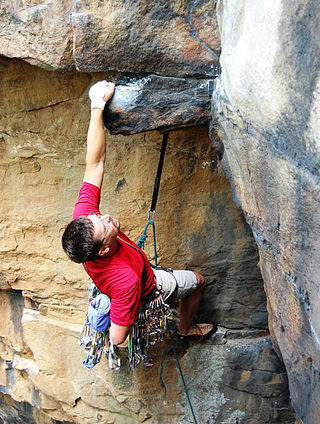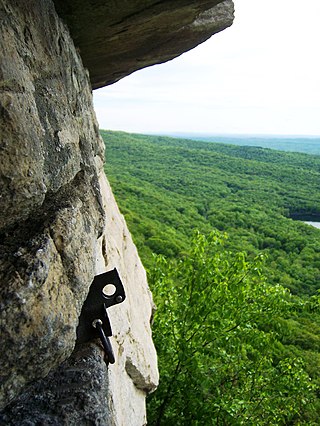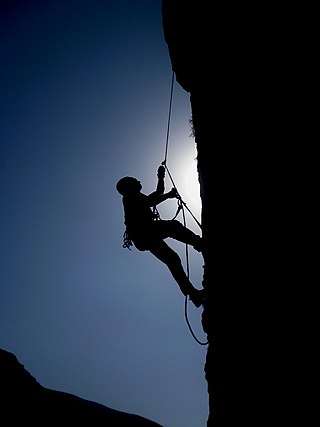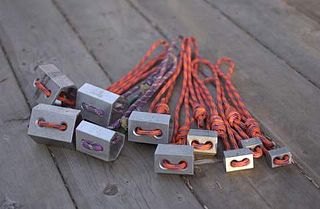
A tricam is a type of climbing protection equipment. [1] A versatile nut/cam hybrid, the Tricam was invented by Greg Lowe in 1973, and came to market in 1981. They are currently manufactured by C.A.M.P. of Premana Italy.

A tricam is a type of climbing protection equipment. [1] A versatile nut/cam hybrid, the Tricam was invented by Greg Lowe in 1973, and came to market in 1981. They are currently manufactured by C.A.M.P. of Premana Italy.
The Tricam is a passive camming device consisting of a carefully shaped aluminium-alloy cam attached to a length of webbing tape. Most sizes are produced as a solid forged unit, but the larger sizes are made from riveted sheet metal.
The device is inserted into a crack so that pulling on the tape makes the piece cam outward against the sides of the crack, gripping the rock tighter. Camming action is achieved by the position of the pointed fulcrum or pivot of the cam relative to the attachment of the tape. As the webbing is pulled, the downward force is pivoted onto the point, which can bite into soft rock or ice and increases the holding power of the tricam. [2]
Tricams are not as easy to place or remove as spring-loaded camming devices (SLCDs) but are cheaper and lighter. Some cracks and pods too shallow to protect with SLCDs are easily protected with tricams. They have no moving parts to freeze, making them an excellent choice for a mountaineer's rack. They can also be used as nuts. [2]
Placing a Tricam takes practice to achieve proficiency. Care must be taken so the Tricam does not loosen while climbing above it due to rope drag. Typically, this additional safety is provided by clipping a longer sling to the tricam. Tricams can "weld" into the placement after being subjected to a hard fall, making them hard to clean and likely to be left behind.
Tricams are available in a range of sizes to suit cracks from 10–140 mm wide. [2] They are especially useful in horizontal cracks, quarry drill holes, and limestone pockets, where they may be the only type of protection that works. The smallest size can also work well in old piton scars.
As manufactured they come in size numbers 0.125 to 7, with strength 2–22 kN, width 10–140 mm, and weight 9–264 g. [2]
Climbing protection is any of a variety of devices employed to reduce risk and protect others while climbing rock and ice. It includes such items as nylon webbing and metal nuts, cams, bolts, and pitons.

A spring-loaded camming device is a piece of rock climbing or mountaineering protection equipment. It consists of two, three, or four cams mounted on a common axle or two adjacent axles, so that pulling on the axle forces the cams to spread farther apart. This is then attached to a sling and carabiner at the end of the stem. The SLCD is used by pulling on the "trigger" so the cams retract together, then inserting it into a crack or pocket in the rock and releasing the trigger to allow the cams to expand. A pull on the rope, such as that generated by a climber falling, will cause a properly placed SLCD to convert the pulling force along the stem of the unit into outwards pressure on the rock, generating massive amounts of friction and preventing the removal of the unit from the rock. Because of the large forces which are exerted on the rock when an SLCD is fallen on, it is very important that SLCDs are only placed in solid, strong rock.

Traditional climbing is a type of free climbing in rock climbing where the lead climber places the protection equipment while ascending the climbing route; when the lead climber has completed the route, the second climber then removes the protection equipment as they climb the route. Traditional climbing differs from sport climbing where the protection equipment is already pre-drilled into the rock in the form of bolts.

A climbing harness is a device which allows a climber access to the safety of a rope. It is used in rock and ice climbing, abseiling, and lowering; this is in contrast to other activities requiring ropes for access or safety such as industrial rope work, construction, and rescue and recovery, which use safety harnesses instead.
This is an index of topics related to climbing.

Webbing is a strong fabric woven as a flat strip or tube of varying width and fibres, often used in place of rope. It is a versatile component used in climbing, slacklining, furniture manufacturing, automobile safety, auto racing, towing, parachuting, military apparel, load securing, and many other fields.

This glossary of climbing terms is a list of definitions of terms and jargon related to rock climbing and mountaineering. The specific terms used can vary considerably between different English-speaking countries; many of the phrases described here are particular to the United States and the United Kingdom.

Rock-climbing equipment requires a range of specialized sports equipment, for training, for aid climbing, and for free climbing. Developments in rock-climbing equipment played an important role in the history of rock climbing, enabling climbers to ascend more difficult climbing routes safely, and materially improving the strength, conditioning, and ability of climbers.

Aid climbing is a style of climbing in which standing on or pulling oneself up via devices attached to fixed or placed protection is used to make upward progress.

In rock climbing, a nut is a metal wedge threaded on a wire that climbers use for protection by wedging it into a crack in the rock. Quickdraws are clipped to the nut wire by the ascending climber and the rope threads through the quickdraw. Nuts come in a variety of sizes and styles, and several different brands are made by competing manufacturers. Most nuts are made of aluminum. Larger nuts may be threaded on Dyneema cord instead of wire, but this has become unusual.

Clean climbing is rock climbing techniques and equipment which climbers use in order to avoid damage to the rock. These techniques date at least in part from the 1920s and earlier in England, but the term itself may have emerged in about 1970 during the widespread and rapid adoption in the United States and Canada of nuts, and the very similar but often larger hexes, in preference to pitons, which damage rock and are more difficult and time-consuming to install. Pitons were thus eliminated in North America as a primary means of climbing protection in a period of less than three years.

A piton in climbing is a metal spike that is driven into a crack or seam in the climbing surface using a climbing hammer, and which acts as an anchor for protecting the climber against the consequences of falling or to assist progress in aid climbing. Pitons are equipped with an eye hole or a ring to which a carabiner is attached; the carabiner can then be directly or indirectly connected to a climbing rope.

Rock climbing is a sport in which participants climb up, across, or down natural rock formations. The goal is to reach the summit of a formation or the endpoint of a usually pre-defined route without falling. Rock climbing is a physically and mentally demanding sport, one that often tests a climber's strength, endurance, agility and balance along with mental control. Knowledge of proper climbing techniques and the use of specialized climbing equipment is crucial for the safe completion of routes.

An ascender is a device used for directly ascending a rope, or for facilitating protection with a fixed rope when climbing on very steep mountain terrain.
In rock climbing, an anchor can be any device or method for attaching a climber, a rope, or a load above or onto a climbing surface—typically rock, ice, steep dirt, or a building—either permanently or temporarily. The intention of an anchor is case-specific but is usually for fall protection, primarily fall arrest and fall restraint. Climbing anchors are also used for hoisting, holding static loads, or redirecting a rope.
The American Death Triangle, also known as the "American Triangle", "Triangle Anchor" or simply the "Death Triangle", is a dangerous type of rock and ice climbing anchor infamous for both magnifying load forces on fixed anchors and lack of redundancy in attachment to the anchor.

CAMP manufactures equipment for climbing and associated activities such as ski mountaineering and industrial safety. The company is based in Italy.

A hex is an item of rock-climbing equipment used to protect climbers from falls. They are intended to be wedged into a crack or other opening in the rock, and do not require a hammer to place. They were developed as an alternative to pitons, which are hammered into cracks, damaging the rock. Most commonly, a carabiner will be used to join the hex to the climbing rope by means of a loop of webbing, cord or a cable which is part of the hex.

Camalot is a brand of spring-loaded camming devices manufactured by Black Diamond Equipment used to secure ropes while rock climbing. Camalots use a dual-axle system, resulting in a slightly higher expansion range than similarly sized single axle units, however that results in significant weight penalty. Dual-axel was patented and for decades was only used by Black Diamond, however the patent has expired in 2005 and several other manufacturers began producing dual-axel cams, often also replicating Camalots sizes and coloring. Most notable Camelot look-alikes include DMM Dragons and Wild Country's New Friends.

Crack climbing is a type of rock climbing in which the climber follows a crack in the rock and uses specialized climbing techniques. The sizes of cracks vary from those that are just barely wide enough for the fingers to fit inside, to those that are so wide that the entire body can fit inside with all limbs outstretched. Many traditional climbing routes follow crack systems, as they provide natural opportunities for placing protective equipment.